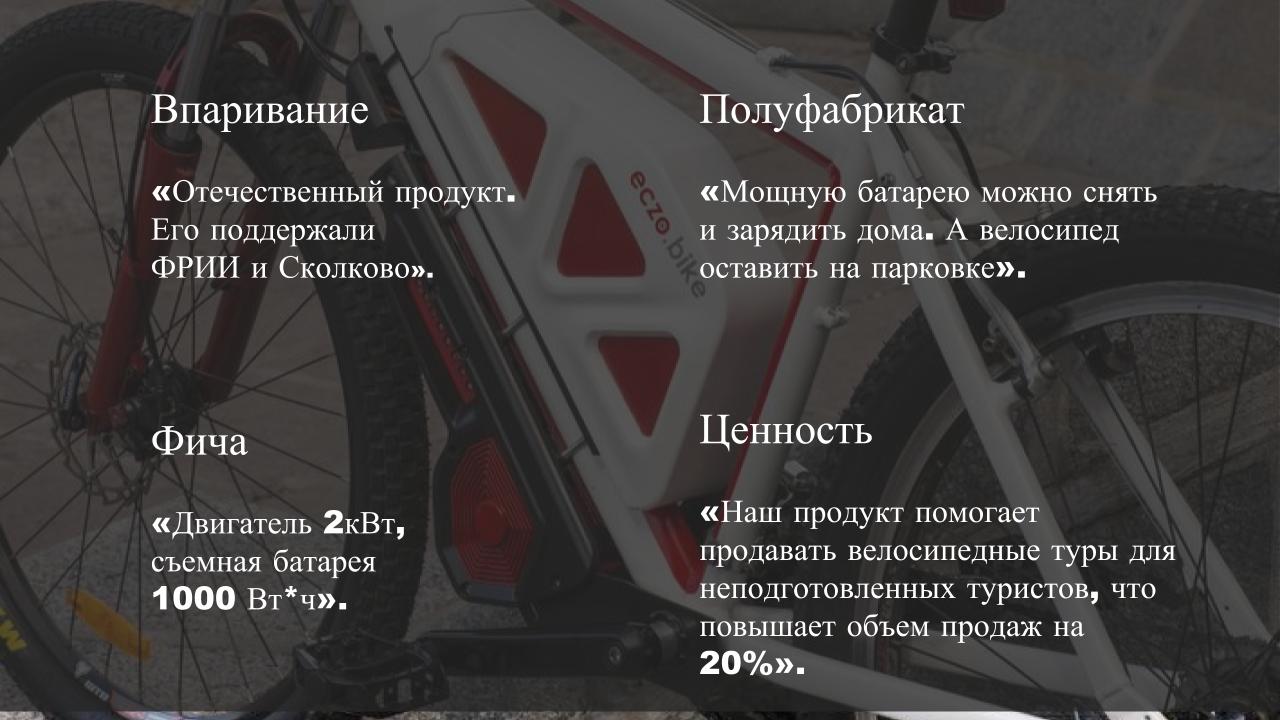How to create a competitive advantage and value of a technological product

At the online conference “How to build a business on the basis of technology,” Dmitry Kalaev, Director of the Accelerator of IDF, told about the types of competitive advantages of tech start-ups, how to formulate value and competitive advantage that will help customers sell the product, and at what point the company should think about scaling.
There are 3 types of competitive advantages around which companies build their business:
- Sales The company is able to sell well and build relationships with customers. And fulfills its obligations after the sale of the product.
- Service It builds quality, friendly and fast service that raises customer expectations from the product. The priority of the company is not quick sales, but customer recommendations that they give to other people after interacting with the company.
- Product . This strategy is closest to the technology business: sales skills and service in a company may not be developed as well, but it has a phenomenal product and technology.

If the market segment is large enough, there will be a place for all three types of companies. Some sell well, others serve, and some have an advantage in a quality product.
But to make a very cool product is not always enough: very often companies with good sales skills or service defeat competitors with a high-quality and technologically advanced product. For example, IBM's “OS / 2” was very reliable and had a good interface, but Windows 95 marketing won out. Therefore, when building a business, you should not forget about the importance of sales and marketing.
')
4 ways to build product value for customers
In the FRIA portfolio there is the company Eczobike. Her product is a set of battery and electric motor for a bicycle. It can be put on 80% of ordinary bicycles, and then it will turn into an electric bike, and even a person with a weight of more than 100 kg will be able to ride it uphill. The battery pack is removed and charged separately from the bike. Such products cost several tens of thousands of dollars. There are several options for building value:
1) Embed - the most favorite way to promote the product from the founders and novice marketers. Rather, they are not talking about the benefits of the product for customers, but about how “cool” their company is. One can often hear phrases from them: “we are number one in this market”, “we are the biggest”, “we are the most innovative”.

The founders of Eczobike just started with what they said: “Our product is domestic, we are engaged in import substitution, we are supported by Skolkovo and IIDF”.
What is their mistake? They talked about their loved ones, and potential customers could not conclude about the value of the product for themselves: the buyer doesn’t really care that the product is in the zone of import substitution - he does not understand why he needs a product.
2) Focus on features - talk only about the characteristics of the product : "Eczobike has a 2 kW engine and a 1000 watt battery."
Most likely, you do not know how much battery you have in your phone, and how many kilowatts under the hood of the car. Therefore, such a value proposition may be relevant for a narrow niche: a person involved in this market and a professional for whom these figures mean something. But for the mass consumer, such a product description is only obscure technical characteristics that do not answer the question of what the customer will receive in the event of a purchase.
3) Focus only on advanced users . A powerful battery that can be removed from a bicycle can be a value and competitive advantage for the customer. But at the first sales stage, the majority may have a misunderstanding: the client may think that he is offered a bicycle, which requires the same attention as a cell phone - as soon as he sees the outlet, he needs to be recharged.
However, a person who has already lifted an electric bike up the stairs for recharging may realize that it is convenient to remove the battery from the bike. That is, in this case, the client of the product may already be an experienced user of an earlier version of the product.
4) Find customer value . For companies that sell bicycle tours in mountainous areas, Eczobike will increase sales by 20% due to the advantages of electric bicycles for non-sports people. And this is the only bike that has a capacity of 2 kilowatts and a battery, which will allow people even with a weight of 100 kg to storm the mountains.

Thus, in order to formulate the competitive advantage of the technology business, it is necessary to understand what the functionality of the product can be really important for the client.
Here the founders of “techies” have a problem: they don’t want to understand the business of the potential client and believe that they have already completed their task of making a cool product. And the client himself will figure out how to use it.
The customer development methodology and its first stage, customer discovery, will help you understand the potential customer’s business - when you go and talk with customers and find out how life works for them, what they think about your product, and what their need for your product will be. So you figure out and value for the client.
If your technical specifications do not generate value for the customer - no one needs your product. Therefore, the number of clients is your competitive advantage.
Select a business segment in which you will work
- B2C - sales to specific individuals.
- B2B-SMB - sales to businesses in the middle segment with checks of 20-100 thousand rubles.
- B2B Enterprise - work with large companies. The transaction cycle can range from several months to several years, and a check can range from 500 thousand rubles to tens of millions of rubles.
Stages in the Enterprise segment can be applied to all business segments, therefore, we consider them on the example of the FRIA Scorista company.

Scorista has a scoring technology that increases the likelihood of a borrower's correct behavior. With the help of its algorithms and excellent mathematics, you can get data about the borrower at the entrance and then decide whether to give him money.
To sell something to a client, you need to tell why he needs our product. In the case of Scorista, it is likely that it is better to go to banks or microfinance enterprises — to any sufficiently large businesses that issue loans. Suppose they have problems:
- They often give out loans to people who would not be worth giving them out.
- They do not give loans to people who could give them.
In both cases, the benefit is lost: in the first - the money, in the second - the client and possible earnings.
To find out if a customer needs our product, you have to go to a bank that has not been engaged in consumer loans before and will be doing it in the coming months. Because in banks that are engaged in consumer lending, scoring, most likely, is already there.
And we may not even have the product and technology itself - but we will already know what they should be.
The second question that is worth answering is how big the market is, and whether it is enough to build a business.

The banking market in Russia is not like a growing one: in our country every day there are fewer and fewer banks and those that are just starting to engage in consumer lending can be counted on the fingers of one hand.
So, you will have 5 clients with potential contracts for 3-6 million rubles. The entire market available to you can be measured at 20-30 million rubles, and you will have competitors there. This means that the market is not enough for you.
When you test hypotheses on a nearby segment, the market becomes larger. Microfinance organizations are in the formative stage in our country, there are several thousand of them now, not all of them have scoring, and some of them give loans according to the “meet by clothes” principle: they see a person in a suit, with a tie and a passport, and decide to give him a loan.
These steps are rather not about technology, but about what we can do for a client with the help of technology. Then the question already arises: how good is our technology.
For example, in the case of Scorista, it is necessary to understand whether technology can help a client to get more money, and whether it will be possible to build a business on it. They come to the client and offer to take his base, to analyze with the help of their algorithms, how effectively they issued loans over the past year: to whom out of 10 thousand people it was worth and not worth giving money.
If the algorithm shows that 20% of people are not worth issuing loans, then everything is fine - the company shows that it saves money to the client: for example, using the services of the company, he could save at least half of the lost 20 million rubles. Scorista can take 1-2 million rubles as payment for its services.
Thus, your task is to find out whether the technology gives the client enough benefit to make him want to pay, and the company has been building its business further. Only after you learn that the technology is suitable for the client, it works and can bring enough money, you can move on and move on to scaling.
When to start scaling a business
You can start scaling only when a client is found and it is clear what benefit your company can bring. At this point, you can connect marketing and hiring a large number of sellers.
One of the main mistakes of the founders is that they begin to do mass marketing and sales at a time when they still do not know and cannot even guess who their customer is. And then the technology, which has not yet found a connection with the market, burns all the money for promotion, and the company finds itself at the bottom of the trough.
In the history of the tech business, it is important to find the first customers, offer them a product, and understand whether it benefits them. If it is hardware, a kickstarter will be the typical way to do this for it, where you will collect several thousand dollars of pre-sales: this will be sufficient evidence that you have enough customers and you can sell.
The full video from the event “How to build a technology-based business” can be viewed on the IIDF Youtube channel .
Articulating and confirming the sales value of the product for customers to technological startups is helped in the Accelerator of the IIDF - this is a program of accelerated business development and an opportunity to attract investments, increase revenues several times, enter new markets, rebuild marketing and sales. In FRII we work with startups according to the customer development methodology, which allowed us to identify the value of the product for customers and find our audience for 370+ IT startups.
Until October 18, 23:59 Moscow time, IIDF accepts applications of IT start-ups to the 14th Accelerator! To apply, you need to fill out a startup profile and sign up for Skype.
Source: https://habr.com/ru/post/340186/
All Articles